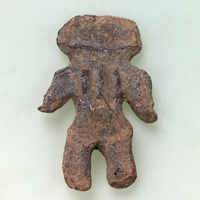Dogu: Objects of Prayer in the Jomon Period
-

Clay Figurine (Dogū) with Mountain-Shaped Head, Found at Tatsugi Shell Mound, Tone Town, Ibarak, Jōmon period, 2000-1000 BC (Gift of Mr. Ebihara Shintaro)
Japanese Archaeology and Special Exhibition (Heiseikan) Japanese Archaeology Gallery
September 8, 2020 (Tue) - February 28, 2021 (Sun)The most prominent objects of prayer from the Jomon period (ca. 11,000 BC–ca. 5th century BC) are dogu clay figurines. Even the earliest examples of these figurines have breasts, which suggests that they represent women, and their protruding bellies probably symbolize pregnancy. Therefore, it is believed that dogu figurines were created to pray for easy delivery of children, the birth of many children, and fertility.
| Designation | Name | Creation/ Excavation/ Provenance |
Period | Acquisition/ Ownership/ Accession Number |
CMT | ||
| Highlight | Important Cultural Property | Clay Figurine ("Dogū") with a Heart-Shaped Face | Found in Higashi Agatsuma Town, Gunma | Jōmon period, 2,000–1,000 BC | Private collection | ||
| Highlight | Clay Figurine ("Dogū") with Mountain-Shaped Head | Found at Tatsugi Shell Mound, Ibaraki | Jōmon period, 2000-1000 BC | Gift of Mr. Ebihara Shintaro J-1577 | |||
| Highlight | Important Cultural Property | Clay Figurine ("Dogū") with Goggle-Like Eyes | Found in Tsugaru City, Aomori | Jōmon period, 1000–400 BC | J-38392 | ||
| Highlight | Stone Figurine ("Gangū") | Found in Nanbu Town, Aomori | Jōmon period, 1,000–400 BC | J-37266 |
